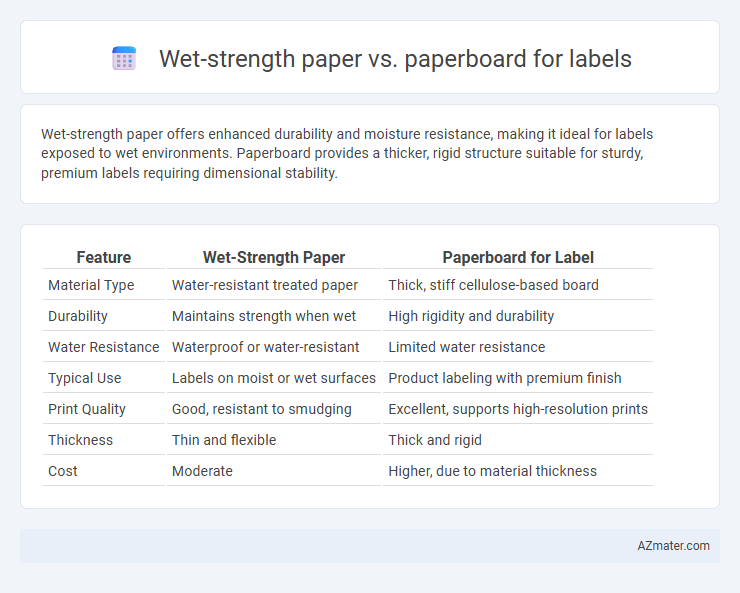Wet-strength paper offers enhanced durability and moisture resistance, making it ideal for labels exposed to wet environments. Paperboard provides a thicker, rigid structure suitable for sturdy, premium labels requiring dimensional stability.
Table of Comparison
| Feature | Wet-Strength Paper | Paperboard for Label |
|---|---|---|
| Material Type | Water-resistant treated paper | Thick, stiff cellulose-based board |
| Durability | Maintains strength when wet | High rigidity and durability |
| Water Resistance | Waterproof or water-resistant | Limited water resistance |
| Typical Use | Labels on moist or wet surfaces | Product labeling with premium finish |
| Print Quality | Good, resistant to smudging | Excellent, supports high-resolution prints |
| Thickness | Thin and flexible | Thick and rigid |
| Cost | Moderate | Higher, due to material thickness |
Introduction to Wet-Strength Paper and Paperboard
Wet-strength paper and paperboard are engineered to resist disintegration when exposed to moisture, making them ideal for labels in damp or humid environments. Wet-strength paper incorporates synthetic resins to maintain integrity and prevent tearing, while paperboard offers increased thickness and durability for heavier-duty labeling applications. Both materials provide essential strength and durability, with the choice dependent on the specific environmental conditions and product requirements.
Composition and Manufacturing Differences
Wet-strength paper contains synthetic resins, such as polyamide-epichlorohydrin, integrated during the papermaking process to enhance water resistance, while paperboard is composed of multiple layers of cellulose fibers pressed together to increase thickness and rigidity. Wet-strength paper manufacturing involves refining pulp with chemical additives to improve durability in moist conditions, whereas paperboard production emphasizes layering and pressing techniques to achieve structural strength suitable for labeling applications. The distinct compositions result in wet-strength paper being ideal for labels exposed to moisture, while paperboard suits applications requiring thicker, more robust label substrates.
Comparative Durability and Water Resistance
Wet-strength paper offers enhanced water resistance compared to standard paperboard, making it suitable for labels exposed to moisture or humidity. Paperboard typically provides greater structural durability and thickness, ideal for labels requiring rigidity and long-lasting physical protection. For applications demanding both water resistance and sturdiness, wet-strength paper balances moisture durability with flexible strength, while paperboard excels in overall toughness.
Printability and Design Flexibility
Wet-strength paper offers enhanced durability for labels exposed to moisture, maintaining print clarity and adhesion under damp conditions, which is crucial for product packaging in humid environments. Paperboard provides superior surface smoothness and stiffness, enabling high-resolution printing and intricate design details, making it ideal for premium or decorative labels. The choice between wet-strength paper and paperboard depends on the balance between moisture resistance requirements and the need for advanced print quality and design versatility.
Adhesion Properties for Label Applications
Wet-strength paper offers enhanced water resistance and durability, making it ideal for label applications exposed to moisture, with strong adhesion properties achieved through specialized coatings and resins. Paperboard provides a sturdy, rigid surface that supports excellent adhesive bonding, suitable for labels requiring structural integrity and high-quality printability. Adhesion on wet-strength paper excels in damp or humid conditions, while paperboard ensures reliable label attachment on more robust packaging materials.
Sustainability and Environmental Impact
Wet-strength paper offers enhanced durability and resistance to moisture, making it ideal for labels exposed to wet or humid conditions while often requiring fewer chemical additives than traditional paperboard. Paperboard used for labels typically provides greater rigidity and structural support but may involve higher resource consumption and longer biodegradation periods, affecting its environmental footprint. Sustainable labeling solutions prioritize recyclable and compostable materials, with wet-strength paper frequently outperforming paperboard in terms of lifecycle environmental impact due to its lower weight and improved recyclability.
Cost Considerations and Availability
Wet-strength paper typically incurs higher costs than standard paperboard due to specialized resins that enhance moisture resistance, making it a premium choice for labels exposed to humid environments. Paperboard offers broader availability and lower raw material expenses, appealing to cost-sensitive projects with less stringent moisture protection needs. Manufacturers must balance budget constraints with performance requirements when selecting between wet-strength paper and paperboard for label production.
Performance in Challenging Environments
Wet-strength paper maintains structural integrity and resists water damage, making it ideal for labels exposed to moisture or humidity, such as in food packaging or outdoor settings. Paperboard, while thicker and more rigid, offers superior durability against physical wear and tear but performs less effectively when consistently wet. For challenging environments requiring both moisture resistance and durability, wet-strength paper provides unmatched performance by retaining adhesion and legibility under adverse conditions.
Industry Use Cases and Application Suitability
Wet-strength paper offers enhanced durability and resistance to moisture, making it ideal for labels used in food packaging, chemical containers, and outdoor products where exposure to water or humidity is frequent. Paperboard provides a thicker, more rigid substrate suited for premium labels on beverage cartons, cosmetics, and retail packaging that require structural support and high-quality print surfaces. Industries such as food and beverage, pharmaceuticals, and personal care select wet-strength paper for longevity under wet conditions, whereas paperboard is preferred for its sturdiness in applications demanding both protection and visual appeal.
Choosing the Right Material for Your Label Needs
Wet-strength paper offers enhanced durability and resistance to moisture, making it ideal for labels exposed to damp environments or handling. Paperboard provides a thicker, more rigid substrate suitable for premium, durable labels requiring structural support. Choosing the right material depends on factors such as exposure to water, required stiffness, and label application, ensuring optimal performance and longevity.

Infographic: Wet-strength paper vs Paperboard for Label
 azmater.com
azmater.com